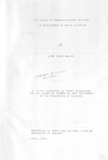The impact of Tanzania-Zambia railway on development of Mbeya District

View/
Date
1978Author
Kasege, John Edson
Type
ThesisLanguage
enMetadata
Show full item recordAbstract
The rail transport 1n Tanzania is closely related
with the history of economic development in the country.
role
The railways have played a crucial .in the location
of economic activities and in transporting commodities
from the production zones to be exported to foreign
markets. With the more government programmes aimed
at increasing agricultural productivity ln the
country, the rail transport 1S required to provide
more and efficient serV1ces to meet the demand in
transportation.
The historical study of the origin and evolution of
East African railways in Tanzania reveals that
1n
railways were responsible. perpetuating the export
oriented economy and in doing so it caused regional
development disparities. The north reg10ns were
being developed while the south which lacked rail
transport facilities was left undeveloped. After
Tanzania attained its independence, the whole outlook
and motive force of the railway underwent radical change.
The railways were called to serve the general public
because it was the people of the Tanzania who would
provide the revenue of railway and generate volume of
traffic.
It is 1n the light of this new approach that the
impact of the new Tanzania-Zambia Railway is being
VI
studied in Mbeya District. Before the railway was
constructed through to Zambia, the district was very
much isolated from the rest of the country In terms of
transportation facilities. The high costs of road
transport discouraged farmers and investors to produce
more or locate their industries in Mbeya. It was
thought that locating industries in this part would be
uneconomic. The completion of the railway project
promises a turning point and it is hoped that rail
transport is to provide cheap and reliable transport
to stimulate growth of economic activities.
The studies, therefore, examines the influence of the
railway on development factors and economic activities
to see how these are changing since the rail transport
began operation. The impact is seen in terms of
changes taking place in population densities, distribution
of settlements and increased programmes in
agriculture and industrial activities being proposed
in the district. The study does not quantify the
impact beGause of lack of data and time available for
detail data collection was short.
In order for the railway impact to be effective in
district development, development strategies are
suggested in the last chapter with the purpose of
stimulating further production in agriculture and
increasing economlC activities In rural areas. It
VII
lS expected that increased productivity from
economic activities in the district will create
demand for rail transport facilities while at the
sametime stimulate rural development.
